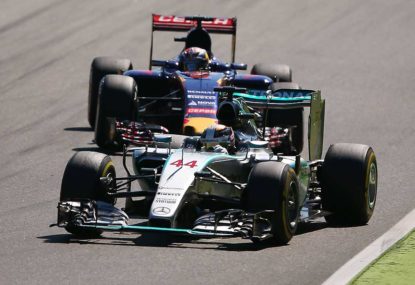Huge shake-up at Team Arrow McLaren for the rest of the IndyCar season: Pourchaire in, Malukas out
Theo Pourchaire replaces David Malukas, who got injured and then fired before he could even sit in the car.

Motorsport fans of every creed arrived to work on Monday morning tired but content having watched the epic MotoGP title showdown late on Sunday night.
The 2015 duel between teammates Valentino Rossi and Jorge Lorenzo climaxed with the former slicing through the field – indeed, almost through the entire field – to finish fourth after starting in P26.
The latter perfectly judged his race from a lap record-breaking pole position to victory under extreme duress from the fast-finishing Honda bikes behind. For Lorenzo it was enough to take home the title, but either would have presented as a worthy champion.
One could not help but notice, however, that in among the Twitter conversation – and somewhere beyond the conspiratorial chattering about an alleged Marc Marquez-Jorge Lorenzo alliance – was a persistent question that hung heavy on the many visitors from the four-wheel world intruding on the spectacle: why isn’t Formula One like this?
The gloom that clings to modern-day Formula One, thickening perhaps during the three-race encore the sport has to reflect quietly and dispassionately post-Lewis Hamilton’s championship, is evidently so pervasive that the success of another motorsport has become a trigger for further negativity.
Luckily enough Formula One is fast approaching a T-intersection that presents an opportunity to move off the path lamented by so many – but to manoeuvre towards a potentially brighter future it needs fast action.
The 2017 regulations, hypotheses about which we have heard endlessly, whether in the form of ‘aggressive looks’ or (deep breath) refuelling, must be finalised ASAP, with final FIA approval due on February 28. So in just three and a half months, a pivotal change of regulations must to be decided.
The first piece has already been put in place with Pirelli, which will allow teams free choice of two of any three pre-selected tyre compounds from next year, whereas currently the tyre supplier brings two compounds of its own choosing with which the teams make do.
Aiding this change is the introduction of a new ‘ultrasoft’ compound, which should move the sport slightly further from its one-size-fits-all approach to matching rubber to circuits.
Beyond the strategic elements it may introduce, the renewed emphasis on mechanical grip is important. Mechanical grip is non-discriminatory and presents that most wonderful thing: a universal challenge with which all teams must equally grapple.
Coupling this with wider tyres in 2017 means the cars have the potential to both be faster and follow each other more closely, which is the first step towards creating the spectacle Formula One so desperately craves.
But the second step, and the one which will prove most costly no matter the direction, will be the revamping of the aerodynamic rules, which are currently the most significant hindrance to exciting wheel-to-wheel racing.
The sport has two options when it comes to its aerodynamic regulations: emphasis on generating downforce with wings and emphasis on generating downforce with the floor of the car. Its decision could make or break its shiny new formula.
Faced with a similar choice when formulating the 2014 regulations, the teams decided it would be cheaper to keep what was essentially the status quo with regard to the downforce-generating parts of the car. That is, to refine regulations around the wings and diffusers and abandon plans to open development of the cars’ undersides.
The lesser talked about aspects of the status quo were that the cars are so intricate at their fronts and rears that the wake caused by one car creates such disruption to a following car that it is prevented from slipstreaming and thus from mounting a challenge for position.
Combined with Pirelli’s degrading tyres, on-track passing would be endangered were it not for the life-support of the gimmicky drag reduction system.
The sport need not, and indeed must not, opt for the status quo for a second time.
With Pirelli’s agreement to compromise on tyre choices when it had previously baulked at outright freedom of choice the sport has an opportunity to shift aerodynamic performance to more benign areas of the car while opening tyres as a field to be exploited.
In doing so the sport can achieve its target to speed up the cars, aid overtaking, and give the smaller teams a leg up in performance.
If consensus can be reached on this simpler set of regulations – a big ‘if’ considering the level of distraction a simple CGI future-Ferrari caused the sport earlier in the year – by 2017 Formula One may have the opportunity to host bike fans in a thrilling final-race championship climax.
But the clock is ticking, and February is just around the corner…
Follow @MichaelLamonato on Twitter.